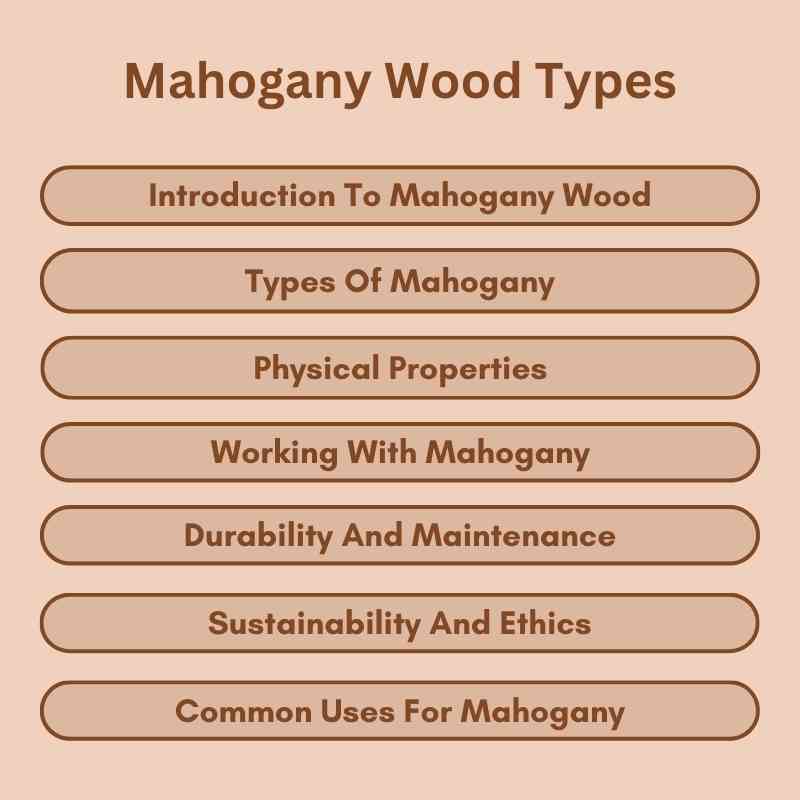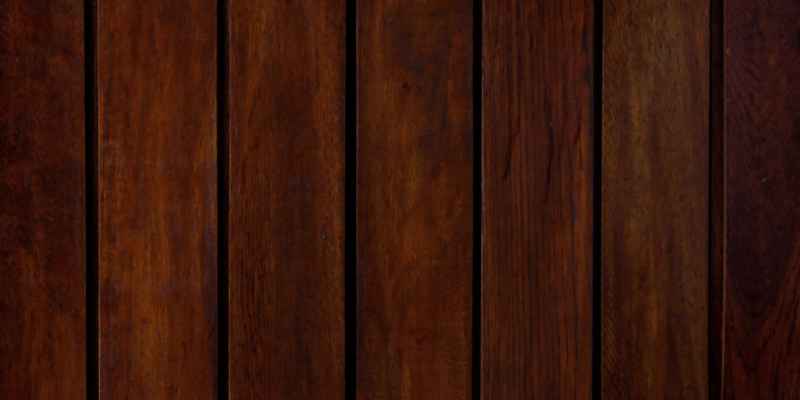Mahogany wood types include genuine mahogany, African mahogany, and Philippine mahogany. Each type offers unique characteristics and applications in furniture and woodworking.
Mahogany is a prized hardwood known for its rich color and durability. This wood has captivated artisans and consumers for centuries. Genuine mahogany, sourced from Central and South America, features a fine grain and deep reddish-brown hue. African mahogany, a more affordable option, has a lighter shade and is widely used in cabinetry.
Philippine mahogany, technically a different species, is popular for its lightweight and workability. Understanding these wood types helps in selecting the right mahogany for your projects, whether you’re building fine furniture or crafting decorative pieces. Choose wisely to enhance both aesthetics and longevity.
Introduction To Mahogany Wood
Mahogany wood is celebrated for its beauty and durability. It comes from several tree species. This wood type is highly sought after for various uses.
Origins And Characteristics
Mahogany has a rich history. It mainly grows in tropical regions. Here are some key characteristics:
- Color: Ranges from reddish-brown to deep brown.
- Grain: Fine and straight, often with a beautiful sheen.
- Durability: Resists decay and insects well.
- Workability: Easy to cut, shape, and finish.
Different types of mahogany exist, each with unique traits. The most common types include:
| Type | Origin | Notable Features |
|---|---|---|
| Genuine Mahogany | Central America | Rich color and grain. |
| African Mahogany | Africa | Lighter color, less expensive. |
| Philippine Mahogany | Philippines | Common for furniture and plywood. |
Popularity In Craftsmanship
Mahogany wood is a favorite among craftsmen. Its appealing look enhances many projects. Popular uses include:
- Furniture making.
- Cabinetry.
- Musical instruments.
- Boat building.
Artisans appreciate its strength and ease of use. Mahogany adds a touch of elegance to any creation.

Types Of Mahogany
Mahogany is a popular wood known for its beauty and durability. There are several types of mahogany, each with unique features. Understanding these types helps in making informed choices for furniture and other projects.
Genuine Mahogany
Genuine Mahogany comes from the Swietenia macrophylla tree. This type is native to Central and South America. It is highly valued for its rich color and fine grain.
- Color: Ranges from a light pinkish-brown to a deep reddish-brown.
- Grain: Straight and uniform, often with a beautiful sheen.
- Durability: Resistant to decay and insects.
Genuine mahogany is often used in high-end furniture and cabinetry. Its workability makes it a favorite among woodworkers.
African Mahogany
African Mahogany refers to several species, mainly Khaya. It grows in Africa and has unique characteristics.
| Feature | Description |
|---|---|
| Color | Dark reddish-brown with lighter streaks. |
| Grain | Interlocked and wavy, giving a distinctive look. |
| Durability | Moderately durable but less than genuine mahogany. |
African mahogany is popular for furniture and musical instruments. It offers a cost-effective alternative to genuine mahogany.
Philippine Mahogany
Philippine Mahogany is mainly from the Shorea species. It is not true mahogany but is widely used in furniture.
- Color: Light to medium brown.
- Grain: Generally straight with a fine texture.
- Durability: Less durable than genuine and African mahogany.
This type is often used in plywood and lower-cost furniture. Its affordability makes it popular for various applications.
Physical Properties
The physical properties of mahogany wood play a vital role in its appeal. Understanding these features helps in choosing the right type for your project. The two main aspects are color and texture variations, and density and hardness.
Color And Texture Variations
Mahogany wood displays a rich palette of colors. Its shades range from light pinkish-brown to deep reddish-brown. The wood often darkens over time, enhancing its beauty.
Texture also varies, providing unique aesthetics. Here are some common variations:
- Flat Grain: Smooth and even surface.
- Interlocked Grain: Creates a wavy pattern.
- Stripe Grain: Features stripes that add character.
These variations make mahogany a popular choice for furniture and cabinetry.
Density And Hardness
Mahogany wood is known for its density and hardness. These properties make it durable and long-lasting. The density ranges from 500 to 800 kg/m³.
Here’s a quick comparison of different mahogany types:
| Type | Density (kg/m³) | Hardness (Janka Scale) |
|---|---|---|
| Honduran Mahogany | 700 | 1,400 |
| African Mahogany | 620 | 1,200 |
| Spanish Cedar | 450 | 900 |
Higher hardness levels indicate better resistance to wear. This makes mahogany ideal for flooring and high-traffic areas.
Working With Mahogany
Mahogany wood is a favorite among craftsmen. Its rich color and smooth grain make it ideal for various projects. Working with mahogany can be rewarding, but it requires specific techniques. Let’s explore how to cut, shape, and finish this beautiful wood.
Cutting And Shaping
Cutting and shaping mahogany is straightforward. Here are some key tips:
- Use sharp tools. Dull blades can cause splintering.
- Choose the right saw. A table saw or band saw works well.
- Make smooth cuts. Maintain a steady hand for best results.
Mahogany can be shaped easily. Consider these methods:
- Use chisels for fine details.
- Power sanders work great for curves.
- Router bits can create decorative edges.
Always wear safety gear. Protect your eyes and lungs while working.
Finishing Techniques
Finishing mahogany enhances its beauty. Here are some effective techniques:
| Technique | Description |
|---|---|
| Staining | Enhances color and grain patterns. |
| Sealing | Protects the wood from moisture. |
| Varnishing | Adds a glossy finish and durability. |
Follow these steps for a great finish:
- Sand the surface smooth.
- Apply stain with a cloth or brush.
- Let it dry before sealing.
- Finish with varnish for shine.
Always test finishes on scrap pieces first. This way, you can see the final look before applying it to your project.
Durability And Maintenance
Mahogany wood is known for its durability and easy maintenance. This makes it a preferred choice for furniture and flooring. Understanding how to care for this beautiful wood ensures it lasts for generations.
Resistance To Decay
Mahogany wood is highly resistant to decay. It naturally withstands moisture and pests. Here are some key points about its resistance:
- Contains natural oils that repel insects.
- Does not warp easily in humid conditions.
- Resists fungal growth, making it ideal for outdoor use.
Due to these properties, mahogany is often used in boats and outdoor furniture. Its longevity makes it a smart investment.
Care And Preservation
Maintaining mahogany wood is straightforward. Follow these tips for care and preservation:
- Clean with a soft, damp cloth.
- Avoid harsh chemicals and abrasive cleaners.
- Apply a wood conditioner every six months.
- Keep it away from direct sunlight to prevent fading.
For extra protection, consider using a quality wood finish. Regular care keeps the wood looking new and enhances its natural beauty.
| Maintenance Task | Frequency |
|---|---|
| Dusting | Weekly |
| Deep Cleaning | Monthly |
| Conditioning | Every 6 Months |
| Refinishing | Every 3-5 Years |
Following these maintenance tips keeps mahogany wood strong and beautiful.
Sustainability And Ethics
Sustainability and ethics are vital in choosing Mahogany wood. This choice impacts the environment and communities. Understanding these aspects helps consumers make responsible decisions.
Environmental Impact
Mahogany trees grow in tropical forests. These forests are crucial for biodiversity. They provide habitats for many species. Cutting down these trees can harm the ecosystem.
Deforestation is a major concern. It leads to soil erosion and carbon release. Protecting Mahogany trees helps combat climate change. Sustainable practices are essential to minimize negative effects.
Certified Sourcing
Buying certified Mahogany ensures responsible sourcing. Look for certifications like FSC (Forest Stewardship Council) or PEFC (Programme for the Endorsement of Forest Certification). These organizations promote sustainable forest management.
| Certification | Description |
|---|---|
| FSC | Promotes responsible forest management worldwide. |
| PEFC | Focuses on sustainable forestry practices. |
Choosing certified Mahogany supports ethical practices. It helps local communities thrive. This ensures fair wages and safe working conditions. Responsible sourcing protects the environment and promotes social equity.
- Always check for certification labels.
- Support brands committed to sustainability.
- Educate others about the importance of ethical sourcing.
Common Uses For Mahogany
Mahogany wood is famous for its beauty and durability. Many people use it for various applications. Its rich color and fine grain make it a popular choice. Here are some common uses for mahogany wood.
Furniture And Cabinetry
Mahogany is a top choice for furniture and cabinetry. Its strength and stability make it ideal for high-quality pieces. Many manufacturers prefer mahogany for:
- Dining tables: They provide elegance and sturdiness.
- Chairs: Comfortable and stylish options.
- Cabinets: Durable and visually appealing storage.
- Dressers: Long-lasting furniture for bedrooms.
Furniture made from mahogany can last for generations. Its resistance to warping and cracking adds to its appeal. Mahogany finishes beautifully, enhancing any space.
Musical Instruments
Mahogany wood is also popular in the music industry. Many instruments use mahogany for its unique sound properties. Here are some instruments made from mahogany:
- Guitars: Provides a warm, rich tone.
- Pianos: Enhances sound quality and resonance.
- Drums: Offers deep, resonant sounds.
- Violins: Produces a smooth and rich sound.
Musical instruments crafted from mahogany stand out for their quality. Musicians appreciate their aesthetic and acoustic qualities.
Choosing The Right Mahogany
Choosing the right mahogany wood is crucial for your project. Different types of mahogany offer unique qualities. Understanding these can help you make the best choice.
Project Requirements
Consider your project’s specific needs. Each type of mahogany has distinct features.
- Durability: Some mahogany types resist wear better.
- Color: Choose a shade that matches your design.
- Grain Patterns: Different grains create unique looks.
- Workability: Some types are easier to cut and shape.
Here’s a table showing common mahogany types and their uses:
| Type | Common Uses |
|---|---|
| Genuine Mahogany | Furniture, cabinetry, musical instruments |
| African Mahogany | Boat building, interior trim |
| Spanish Cedar | Cigar boxes, outdoor furniture |
Cost Considerations
Cost varies based on type and quality. Genuine mahogany tends to be more expensive.
- Genuine Mahogany: Higher price due to rarity.
- African Mahogany: More affordable and widely available.
- Spanish Cedar: Budget-friendly option for many projects.
Consider your budget before making a choice. Quality often affects the final price. Investing in better wood can enhance durability.

Frequently Asked Questions
What Are The Main Types Of Mahogany Wood?
The main types of mahogany wood include Honduras, African, and Santos mahogany. Honduras is prized for its rich color and durability. African mahogany is more affordable and often used in furniture. Santos mahogany has a dark hue and is known for its hardness and stability.
How Is Mahogany Wood Used In Furniture?
Mahogany wood is commonly used in high-quality furniture. Its beautiful grain and rich color make it appealing for cabinets and tables. It is durable, making it suitable for both indoor and outdoor use. Craftsmen appreciate its workability and ability to take finishes well.
Is Mahogany Wood Environmentally Sustainable?
The sustainability of mahogany wood depends on its source. Certified sustainable mahogany is harvested responsibly, minimizing environmental impact. However, some sources face deforestation issues. Always look for certifications like FSC to ensure ethical sourcing when purchasing mahogany products.
What Are The Benefits Of Using Mahogany Wood?
Mahogany wood offers numerous benefits, including durability and resistance to decay. It has a stunning appearance, enhancing any space. Additionally, it is easy to work with and can take stains and finishes beautifully. Mahogany is also less prone to warping, making it a reliable choice for various applications.
Conclusion
Mahogany wood offers a rich blend of beauty and durability. Understanding its various types can enhance your woodworking projects. Whether you choose African, Honduran, or Cuban mahogany, each variety brings unique qualities. Selecting the right type ensures your pieces stand the test of time while showcasing stunning aesthetics.
Embrace the elegance of mahogany in your creations.

